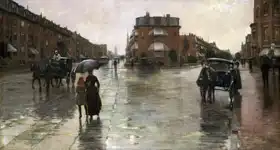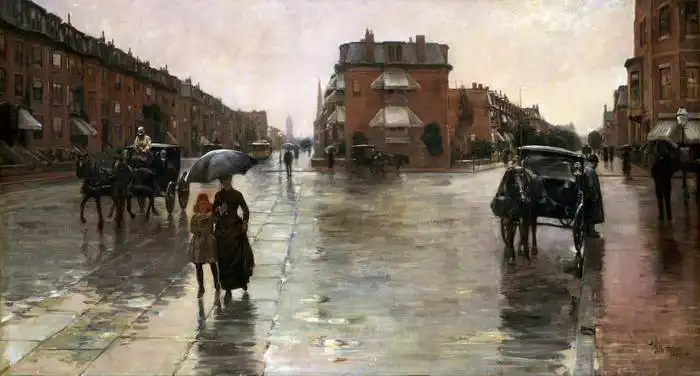About this finishing
Print. The image is printed on the top quality 10-ink HP Z9PS printer on HP matte 270 g / m2 paper. You can choose any size to an accuracy of 1 cm. A margin of 5 cm around the image is added to the size of the motif.


You can find a detailed description about our finishings
here.
Rainy day in Boston
The image depicts a historic city scene, with people and carriages moving over wet, shiny tiles, presumably after a rain. The street is lined with a row of tall buildings, and two horse-drawn carriages driving towards each other appear to be the main means of transport. In the foreground two people, one with an umbrella, can be seen crossing the street together. The historic nature of the buildings and the people's clothing is evident, suggesting that the scene may date from the 19th or early 20th century.
This description was created by artificial intelligence, please be indulgent.
Prevailing color of this fine art print is dark and its shape is long. This image is printed on demand - you can choose material, size and finishing.
Childe Hassam (1859-1935) was an American
Impressionist painter, for whom characteristic scenes are urban -
Rainy Day in Boston, and coastal -
South Ladges scenery. He was born in Dorchester, Massachusetts. His father was an average merchant but an above-average art collector. It is no wonder, then, that Hassam soon showed a love for art. However, he was also an excellent athlete. He excelled in boxing and swimming. He did not finish his studies at the university due to a devastating fire in Boston, which destroyed his father’s business. He found a job with the publisher Little, Brown & Company, where he created designs for letterheads and newspapers. In 1883, he travelled with his friend Edmund H. Garrett to Europe, where he studied the Old Masters of Great Britain, the Netherlands, France, Italy etc. The works of
William Turner especially fascinated him. On this journey, he created 67 watercolours, which became the basis of his second exhibition in 1884. He lived alternately in Europe and America, where he taught at art schools and painted. He was a member of the
Impressionist group The Ten. In the last years of his life, he travelled around the United States. He died in East Hampton in 1935, aged 75, and his works are recognizable by the crescent brand, which he added to his signature.


